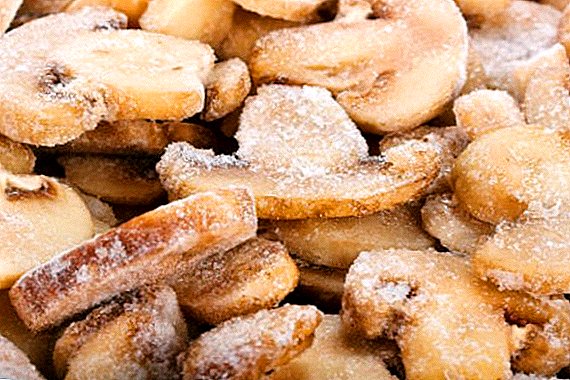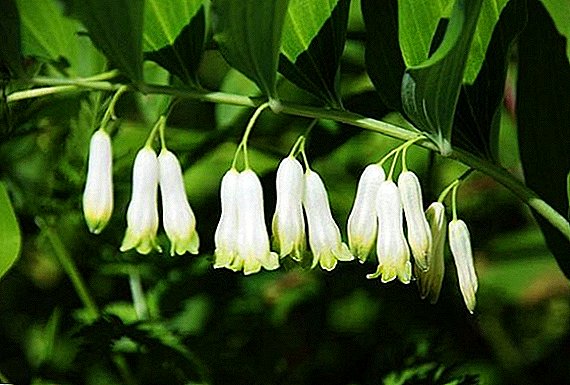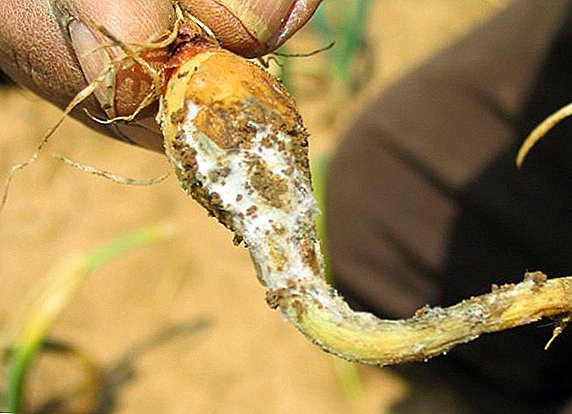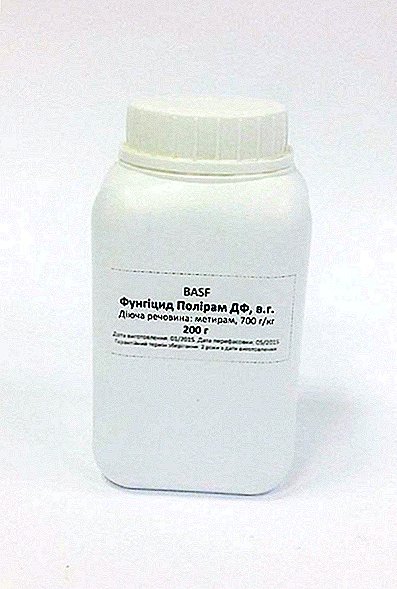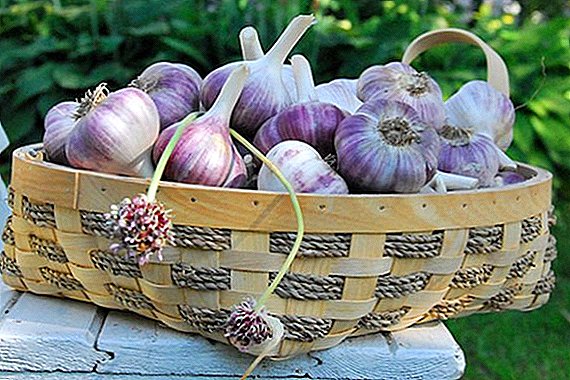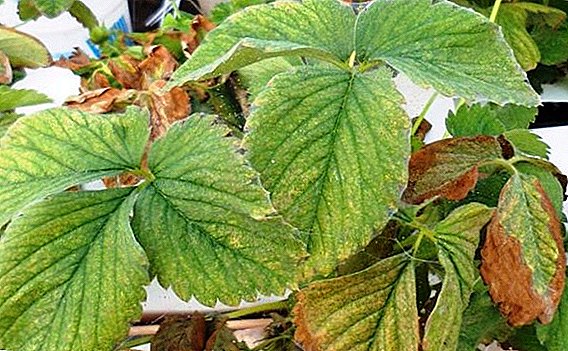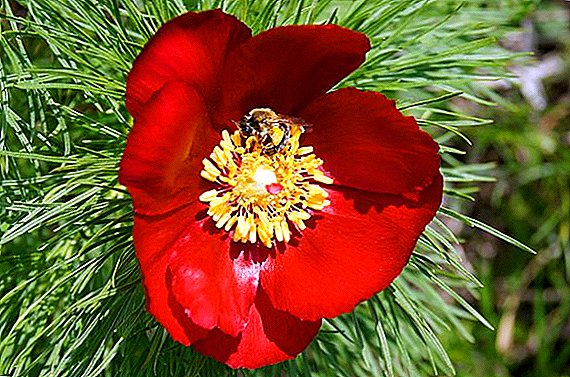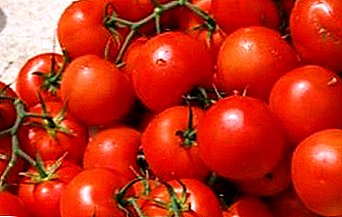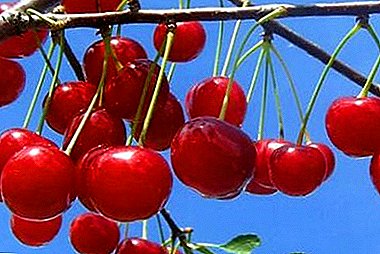
Modern gardeners is not easy to choose for themselves the perfect variety of cherries. Perhaps for fruit-breeding enthusiasts who live and work in the central regions of Russia - the most "cherry" part of the country, this will be Grade Dessert Morozova.
It is as if this cherry was created in order to successfully survive the harsh Russian winter and quickly fill with juices, to please a man with his rich and sweet harvest. Well, the name of the creator of this species is well known - it is contained in its very name.
Morozova Dessert Cherry - variety description, fruit photo, gardeners' reviews about its characteristics and properties later in the article.
Breeding history and breeding region
 Dessert Morozova is a relatively young variety. The year of his birth is 1997.
Dessert Morozova is a relatively young variety. The year of his birth is 1997.
At the same time, a well-developed and tested culture was entered into the Russian State Varietal Register.
And since then, thanks to its valuable qualities, it remains very popular among gardeners - professionals and amateurs.
The author of the variety, who gave the novelty not only life, but also the name, was a well-known breeder, candidate of agricultural sciences and a recognized specialist in the development of stone fruit, T. Morozova. Her hand also owns Lebedyanskaya, Tamaris.
Like most of her cherry and cherry "works", Tamara Vasilievna created the Dessert on the basis of All-Russian Research Institute of Horticulture and Nursery. I.V. Michurin (Michurinsk, Tambov region).
This research institution is well known in Russia and abroad for its high-profile developments, the goal of which has always been to create cultures that are well adapted to modern natural and environmental conditions.
As for the variety Dessert Morozova, the Vladimirskaya cherry variety was used as the basis for its creation.
 In the process of selection, the seeds of the "parent" species in the germinated state were treated with the chemical substance ethyleneimine (EI) by the mutagen.
In the process of selection, the seeds of the "parent" species in the germinated state were treated with the chemical substance ethyleneimine (EI) by the mutagen.
The concentration of mutagen was about 0.1%.
After breeding and entering the state register, the variety was zoned for preferential cultivation across the Central Black Earth region (Russia).
Hope, Lyubskaya, Novella are also suitable for growing in these territories.
Appearance of cherry Dessert Morozova
The following appearance signs are inherent in the Morozova Cherry Dessert:
Tree
Usually characterized medium tall (sometimes lower or higher than average height). Tree bark covers the bark of a light brown hue.
Crown, branches. The crown is wide enough in scope, formed by durable, spreading branches covered with light brown bark. As a rule, it has a shape close to the shape of a ball. Usually contains a moderate amount of leaves (medium foliage). Similar signs are also demonstrated by the Griot of Moscow, Lebedyanskaya and Morozovka.
Shoots. The elongated shoots are gray-green in color. A small amount of lentils is formed on their surface.
 The buds have a rounded ovoid shape, significantly deviated from the surface of the shoot. Fruiting occurs both on the bouquet branches and on the annual increments (in the latter - to a greater extent).
The buds have a rounded ovoid shape, significantly deviated from the surface of the shoot. Fruiting occurs both on the bouquet branches and on the annual increments (in the latter - to a greater extent).
Leaves. Dessert Morozova leaves are characterized by light shades of dull green. The size of the usual for this cherry leaf is more than average. The shape is obovoid.
The leafless leaf has a smooth to the touch surface. On the edge of the sheet, biconorigular serrations are observed. At its base you can see 1-2 small reddish glands.
Leaves are kept on shortened petioles of medium thickness. On the petioles there are also glands of red color.
Inflorescences On the tree in the spring in the form of roses bloom large size white flowers. Petals are rounded. The stigma of the pistil and stamens have different heights.
Fruit
Round, quite large and weighty cherries (average fruit weight is within 4.7-5.0 g) at the base they have a moderately large groove and apex with noticeable concavity. On the abdomen of the berries is fixed barely noticeable seam.
The peel is colored bright red, there is a small amount of small subcutaneous spots.
 The flesh of the same red color does not differ in special density, there is a lot of juice in it.
The flesh of the same red color does not differ in special density, there is a lot of juice in it.
Inside the fruit, a medium-sized, rounded bone is hidden, which is easily separated from the pulp. The berry is kept on the branch by means of a sufficiently long stalk.
Between the berry and not thick stalk there is a separation layer. Further in the article description of the sort of dessert cherry Morozova and photo of the fruit.
Characteristics of a variety
Winterhardy grade cherry Dessert Morozovaas the same age grade refers to partially self-fertilized. In terms of its ability to fertilize with its own pollen, this category occupies an intermediate position between self-bearing and self-infesting species.
Such affiliation means that the culture in question through its own genetic material can tie from 7 to 20% of the entire fruit array.
Thus, in order to be able to shoot decent yields, Morozova Dessert Cherry requires additional pollinating trees from the outside.
The best options here are such varieties as "Griot Rossoshansky", "Griot Ostheims", "Student", "Vladimirskaya".
 In addition, cutting is an effective breeding method. Such a method under certain conditions gives up to 70-75% rooting of Dessert Morozova.
In addition, cutting is an effective breeding method. Such a method under certain conditions gives up to 70-75% rooting of Dessert Morozova.
At the same time, the Vladimirskaya cherry is considered the best stock (the tree on which the cuttings are planted) for this variety.
According to the standard, Dessert, like Podbelskaya, ripens early. The harvest under the condition of sunny warm weather is removed in the first decade of June. However, the maximum charges of ripe produce can be expected only 3-4 year after planting this variety.
At the stage of full ripeness, the fruit fully justifies the name of its variety. Cherries are not only very attractive in appearance, but also very tasty.
The pronounced sweet taste of the fruit is marked by soft dessert notes, with a light and very pleasant refreshing sourness (Dessert Morozova cherries have a significantly reduced acidity). Varieties Volochaevka, Zhukovskaya and Lebedyanskaya have a good sweet taste.
The chemical composition of the dessert cherry Morozova:
| Composition | amount |
|---|---|
| Sahara | 12,78% |
| Acids | 0,90% |
| Vitamin C | 10.0 mg / 100 g |
 Tree bears fruit every year. Harvest has good transportabilitywhich makes the variety interesting in terms of possible sale in agricultural markets.
Tree bears fruit every year. Harvest has good transportabilitywhich makes the variety interesting in terms of possible sale in agricultural markets.
As gardeners of Michurinsk, the homeland of Dessert Morozova, note, Yield of this cherry on average reaches 55-70 centners per hectare (35 kg from one tree).
Among the high-yielding varieties worth paying attention to the varieties Turgenevka, Ural Ruby and Rossoshanskaya black.
This cherry is not only beautiful in appearance, but also very useful for the human body. It, in particular, contains enough a lot of copper, cobalt, iron - blood-forming chemical elements, helping with anemia. Varieties Chernokorka, Uralskaya Rubinovaya and Kharitonovskaya also possess useful properties.
For the removal of toxins of nitrogenous compounds "responsible" pectins contained in cherry berries. Effective bactericidal trace elements are present in the Dessert Pulp.
Besides, Cherry is a nutritionally valuable product. When it is consumed, the appetite gets better, metabolism of proteins and fats improves, intestinal functioning is normalized. Finally, cherry tree fruits quench their thirst perfectly.
A photo





Planting and care
Before embarking on planting a sapling, it is necessary to carefully prepare a place for a future adult tree and provide for the maximum possible nuances.
In particular, for the Dessert Morozova specimen, it is better to select a plot size 3x3 meters. Within the limits of such a square, the root system, the basis of any plant, can develop normally deeper and broader.
 Of course the landing site should be located on the sunny side of the garden.
Of course the landing site should be located on the sunny side of the garden.
It is desirable that there be as few drafts as possible, winds, and groundwater does not come too close to the surface of the earth. (no closer than 1.5-1 m).
You should also pay attention to soil quality at the planting site.
It should consist of chemically neutral (by acidity) loam, sandy or sandy sand.
In the center of the improvised square for planting trees digging up a hole with a depth of 40-60 cm and a diameter of 50-60 cm.
The soil withdrawn from the hole should not be thrown away. It is mixed with mineral and organic fertilizers (humus, humus) for the subsequent backfilling of seed roots.
In the process of planting a seedling in a hole set vertically, straighten its roots.
After filling the hole with a mixture of soil and fertilizer near the trunk within a radius of 40-50 cm gently compacted any means at hand.
The first watering immediately after planting is not less than 3 buckets of cold cold water.
After watering sagging under the action of moisture soil Sprinkled with a 2-inch layer of mulch from sawdust and humus.
Standard plant care includes regular tree irrigation (per adult plant - at least 4 times a month for a bucket of water in the morning and evening), loosening the soil around the tree, periodic pruning.
When pruning are usually shortened bare branches of the crown.
If this pruning is neglected, then the number of bare branches will greatly increase, which will necessarily have a negative impact on the yield of cherries.
Diseases and pests
In general, the variety Dessert Morozova demonstrates good resistance to fungal diseases.
but with severe infection spores of the fungus Sossomuse s hiemalis - the causative agent of the disease coccomicosis - this cherry may have an average indicator of sustainability to this particular ailment.
With such an infection, the leaves of the cherry tree become covered with reddish spots. Soon the leaf cover begins to dry out rapidly and falls off before the time. This leads to a weakening of the plant, losing the ability to eat normally, and premature death.
A good resistance to fungal diseases demonstrate varieties Molodezhnaya, Morozovka, Nadezhda and Novella.
If the dessert cherry Morozova still got sick, it is necessary to start her treatment without losing time. To do this, held triple wood processing fungicides.
The first time the treatment is done before the buds bloom, the second time - at the very end of the flowering process, the third time - 2-3 weeks after the flowering period ends.
 From rodents which can damage the bark in the winter and the lower branches of the cherry will save the wrapping of the bottom of the tree special mesh or any dense material.
From rodents which can damage the bark in the winter and the lower branches of the cherry will save the wrapping of the bottom of the tree special mesh or any dense material.
As it is not difficult to notice, planting, caring for the specified variety, pest and disease control do not differ much from how it is done with other varieties of cherries.
But the gardener will have to do all this to get a product that is great in taste and healthy.


